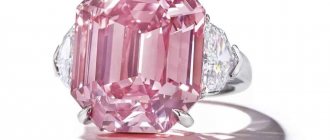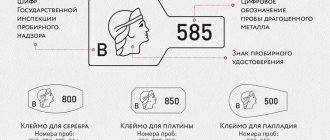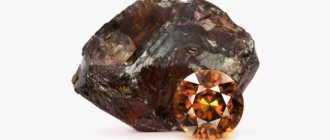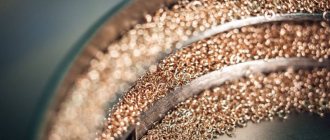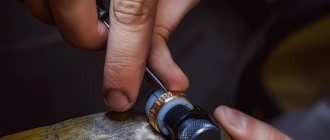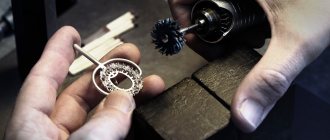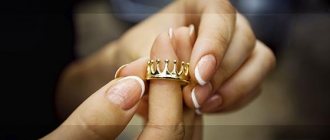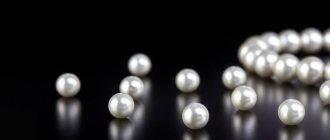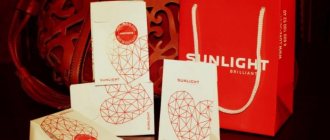Diamond is a winner in many categories. It is the hardest, most mysterious and expensive among natural gems. This is a rare mineral. To extract just one carat, you have to turn over 250 tons of ore. Diamonds can be valuable or not, so you need to know what to look for when buying jewelry with such a stone, and what types of diamonds exist.
International classification of diamonds 4C
A rough diamond is a pale translucent or colored crystal of extraordinary hardness. Translated from Arabic, “almas” means “the hardest.” The Greeks gave it the name “adamas” - “indestructible”. After processing, the mineral takes on the appearance of a sparkling jewel.
Generally accepted classification of natural diamonds:
- Jewelry is the best representatives of these stones. They account for 20% of all precious minerals mined. Such gems can be cut and processed in other ways and weigh no less than 0.29 ct. They have no serious defects. The group of jewelry stones includes colorless (classic), colored (fancy) and black samples. The most common colored diamonds are yellowish, brown, gray, and brownish. A rare variety of diamonds - pink-purple, green, blue, red.
- Technical (80% of samples) are unsuitable for jewelry processing. This includes stones with a damaged structure, multiple inclusions, dull, almost opaque samples.
- Board (board) - diamond chips, fused crystals, fragments of minerals. Diamond beads are used in jewelry and industry for the manufacture of abrasive surfaces.
To assess the quality of cut diamonds, a special international classification of diamonds 4C has been adopted, which includes four parameters:
- Clarity - purity. The fewer inclusions a mineral contains, the better. To detect the smallest foreign inclusions, equipment that provides multiple magnification is used.
- Color – color. A separate criterion is the degree of its saturation and the nature of the shade for fantasy samples. The most valuable are colorless specimens, and among colored ones - stones of a pure shade without shimmer. The rarest are red diamonds.
- Carat – weight of the stone in carats (1 ct = 0.2 g). Crystals less than 0.29 cm are small, from 0.3 to 2.99 are medium, starting from 1 cm are large. If the weight of a stone is more than 5 ct, it is considered “especially large”. Giant diamonds heavier than 10 ct (the rarest diamonds) are given names. One large gem is more expensive than a handful of small crystals, even if their total weight is the same.
- Cut - cut. Processing helps to reveal the play of the stone, highlight the color and veil tiny defects.
Determining the quality of such precious stones is carried out using other methods:
- GIA – diamond grading developed by experts from the Gemological Institute of America;
- HRD (IDC) – classification proposed by the Higher Diamond Council of Belgium;
- CIBJO is a grading scale compiled by the International Confederation of Jewellery, Silver and Pearls;
- Scan D.N. – Scandinavian methodology;
- GOST is the Russian assessment system.
Natural and artificial diamonds - how to determine
Synthetic stones are created in laboratories using chemicals. However, this does not mean that synthetic diamonds are fake or imitation. These are the same diamonds, although they are created by man and not by nature.
You can distinguish an artificial stone (cubic zirconia) from a truly natural one using one of the methods below.
- Rate his class. Natural stones often have various types of defects.
- Breathe on the diamond. Condensation will persist on artificial stone longer than on natural stone.
- Compare color spectrum. It is richer on a man-made diamond.
- Test with x-ray. Natural stone will not appear in the photo.
- Compare mass. Artificial stone is slightly heavier than natural stone.
European classification by purity groups
One of the price-determining indicators for natural diamonds is the presence of cracks, chips, hard and gas inclusions, and impurities that impart pigmentation. External and internal defects affect the quality of the crystal because they prevent the stone from fully reflecting color.
It is customary in the world to classify diamonds according to purity groups, designated by Latin letters:
- FL (Flawless) – crystal clear without inclusions.
- IF (Internally Flawless) - samples without inclusions, but with external defects - cracks, scratches.
- VVS (Very Very Small Inclusions) are minerals with tiny inclusions that cannot be seen without the use of powerful magnifying devices.
- VS1, VS2 (Very Small Inclusions) - crystals in which there are inclusions of such a size that they can be seen with a 10* jewelry loupe.
- SI (Small Inclusions) - gems containing foreign impurities that are clearly visible through a 10x magnification magnifying glass.
- I (imperfect) – diamonds containing inclusions visible to the naked eye.
This is a European classification that allows even a non-specialist in jewelry to get an accurate idea of the quality of a diamond.
Diamond classification according to the GIA system
US jewelers did not want to be satisfied with the European scale and developed their own method of dividing diamonds into quality groups. It was compiled by the Gemological Institute of America in 1960. It covers the same four indicators of the value of a natural gem.
Diamond characteristics according to the GIA system:
- Clarity or purity - the absence of damage and inclusions in the middle and on the surface of the stone. To examine a diamond, magnifying equipment is used (from a 10x gemological loupe to a microscope). Natural mineral formations cannot be 100% transparent. The most valuable specimen has a purity that is designated as “near perfect.” Such a stone seems crystal clear, even with a magnifying glass it is impossible to see any defects or foreign objects in it.
- Carat weight – the weight of the gem, expressed in carats. The mass of the mined raw material nugget is several times higher than the weight of the processed stone. After cutting, the mineral “loses weight” by 1.2, or even 2-3 times. Large samples are highly valued and have investment attractiveness.
- Color – characteristic by color. The color examination is carried out “manually”, that is, the jeweler examines the diamond in the light to highlight the shades and degree of color intensity. A colorless diamond is most valued, but there are exceptions to this rule. Today, colored diamonds are in fashion, among which red, pink, blue and green diamonds are in high demand. Such gems are found extremely rarely in nature and cost $1-3 million per carat.
- Cut – quality of cut. If the master cutter has coped with his task, then the light passes through the crown of the stone, plays inside the crystal and, reflected back, scatters with silver sparks. There are many varieties of cuts. They try to give colorless stones the maximum number of facets. Fancy diamonds are processed differently: a platform is left on the top part, and the pavilion is provided with edges. This allows you to create the illusion that the color comes from deep within the mineral.
Color classification table in the GIA and GOST systems
The tag attached to the jewelry with the gemstone and the certificate for the mineral must indicate the purity and color parameters. According to the European and American scale, they are marked with letters.
Russian diamonds are classified according to GOST standards. According to the domestic standardization system, the quality of stone is indicated not by letters, but by numbers from 1 to 8 (with subcategories).
An idea of the correspondence of color gradation is given by a comparative table of diamond classification in the GOST and GIA systems.
| GIA | GOST system | Description | ||
| Up to 0.29 ct | From 0.3 ct | |||
| 17 faces | 57 faces | 57 faces | ||
| D | 1 | 1 | 1 | Colorless or with an inexpressive bluish tint |
| E | 1 | 2 | 2 | Subtle shade of aquamarine or greenish tint |
| F | 2 | 3 | 3 | There is a slight tint |
| G | 3 | 4 | 4 | There is a tint, but it can only be noticed when compared to a completely transparent sample |
| N | 3 | 4 | 5 | Faint light smoky, pale yellow, light brownish, purple tint |
| I | 4 | 5 | 6, 6a | Light shade of brown, yellow, gray, green. Such stones represent the most optimal ratio of cost and consumer properties of the crystal |
| J | 4 | 6 | 7, 7a | A more noticeable yellowish, gray or brown tint of color. Overall acceptable diamond quality for its price |
| KL | 4 | 7 | 7, 7a | Clearly visible yellow-brown color |
| MN | 4 | 7 | 7, 7a | Pronounced color tint, indicating low quality stone |
| OR | 4 | 7 | 7, 7a | Intense color tint. Transparency no less than 60% |
| SZ | 5 | 8 | 8 (1-5) | Bright lemon, brown shade. There are many flaws, transparency ranges from 30-60%. Low quality sample with low cost |
Any shade is a minus for a diamond.
The higher the transparency and lighter the mineral, the more valuable its jewelry value. All fancy diamonds are necessarily accompanied by a certificate indicating the color gradation and the origin of the shade (natural or artificially obtained as a result of radiation exposure of the mineral).
Why do you dream about a diamond?
A diamond is an amazing stone: the hardest and, other things being equal, the most expensive. Since ancient times it has been endowed with magical properties. It is believed that a diamond can enhance a person’s leadership qualities, sharpen intuition, and improve thinking abilities. It also protects against negative energy.
Constantly wearing diamonds benefits only strong individuals. This stone can suppress those who are weak in spirit, provoke them into unmotivated aggression, and even plunge them into the abyss of madness.
According to the dream book, diamonds are usually a good thing in dreams. However, a lot depends on how you dream about diamonds, what you do with them, what type of jewelry they are set into, and so on. And the position of dream books on this matter varies quite a lot. This is not surprising, because there is nothing more subjective than the interpretation of dreams. It is not possible to check whether the predictions coincide with the actual result.
Gold earrings with topazes and diamonds (go to the SUNLIGHT catalogue)
If a woman dreams of diamonds, perhaps she is simply dreaming about them, and her dreams are reflected in her dreams. However, dream books interpret such dreams differently.
If a woman sees diamonds on herself or received as a gift, this may portend for:
- girls - meeting the love of your life and a quick successful marriage;
- for a married lady - the love and fidelity of her husband, healthy and smart children;
- for a mature woman - an unexpected gift (possibly not cheap) and career advancement.
The average man dreams of diamonds much less often. As a rule, they foretell success in business, a significant leap upward in terms of career, and receiving a decent income from an unknown source.
Oddly enough, diamonds have been considered masculine stones since ancient times. And women were instructed to wear them with caution - not all the time and after reaching adulthood.
Types of diamonds by color and their names
All diamonds are divided into two large categories based on color - white and colored. White (also called colorless) are completely transparent specimens or specimens with a subtle tint in yellowish, blue or pale brown tones.
The price of such gems depends on their purity and ability to reflect light efficiently. The higher the transparency, the more expensive the diamond. The cheapest and most common are diamonds with a yellow sheen. They make up the vast majority of the assortment of a regular jewelry store.
Colored (fancy) diamonds include a wide group of diamonds of all possible color variations. All of them are divided into the following types:
- Brown. Cognac diamonds are formed in nature when tiny particles of iron enter their composition (at the stage of “birth” of the mineral). Brown diamond is the cheapest variety of fancy diamonds.
- Yellow, lemon. In terms of cost per carat they occupy second place after brown ones. Lithium gives the natural sunny shade to the stones. This substance penetrates into the crystal lattice of the mineral during its formation.
- Blues are rare examples in the family of colored diamonds. The heavenly hue is the result of the presence of aluminum inclusions in the crystal lattice of the gem. Blue diamonds are in great demand and are highly valued. Indigo-colored specimens are even rarer. The unusual deep blue tint is due to the presence of boron. Instances that are intensely colored blue are considered unique and are more expensive than all other representatives included in this group.
- Pink are exclusive diamonds. They are mined in only three places in the world - Australia, South Africa, and Brazil. Manganese gives the flamingo color to the stones. Bright samples without color variations are most valued. The presence of a brown or yellowish tint is considered a disadvantage and reduces the price of the stone.
- Violet diamonds are rare and expensive. In terms of cost they are in third place after red-pink and green. The purple color is explained by the presence of large volumes of hydrogen in the mineral.
- Green is an elite variety of diamond. The “grass” color is due to chromium impurities. Such nuggets are found in nature in extremely limited quantities. The color standard for these minerals is a rich shade of ripe green apple. The price of a carat of a naturally emerald-colored diamond starts at $250 and goes up to $1 million.
- Black. The scientific name for coal-colored diamonds is carbonado. This mineral is also known as hazy diamond. In terms of price, these are not the most expensive samples. They do not have the play of stone characteristic of diamonds. Carbonado is an opaque mineral that is difficult to process. Graphite gives the rock its black color. Such gems are a rare type of diamond; all examples are known by comparison. Only artificially “darkened” diamonds can be found on sale. They are obtained by heating low-quality cut stones to critical temperatures.
- Red diamonds rank first in rarity among colored diamonds. Such unique pieces come across once every few decades and cost from $2 million per carat. Wine-colored diamonds are sold exclusively at auctions or are custom-made for a specific multi-billionaire buyer. There are no impurities or color pigments in these stones. Scientists believe that they acquired color under the influence of natural radiation exposure.
A popular new item of the season is the smoky diamond.
This is the name given to diamonds of different colors set into jewelry. If you look closely, inside each such crystal you can see scattered “specks of dust” - point inclusions inherent in diamonds.
Diamond rings and horoscope
The diamond is ideal for the fire signs of the zodiac: Aries, Leo and Sagittarius. These people are usually impulsive, prone to nervous and depressive behavior. The solar energy of a diamond nourishes them with energy and returns them to a joyful, harmonious mood. The unbreakable structure of this stone symbolizes stability and brings it to the life of its owner. According to the conclusions of ancient Egyptian astrologers, the diamond is the first stone of the zodiac. The first in the series of signs is the sign of Aries. For this reason, the diamond is recommended by astrologers to people born under this sign. The fact is that they quite often and actively spend mental and physical energy, and need periodic recharging. A diamond successfully performs this function: it relieves the blues and brings bright colors to the world around us.
Regardless of the date of birth, a diamond protects people from illness, injury, physical and mental, and attracts good luck.
Color scale for diamonds of different sizes
The color of diamonds is assessed according to the size of the stone. Minerals weighing from 0.30 ct are divided into 9 color options, small diamonds weighing below 0.29 ct and cut into 57 facets belong to one of 7 color groups. Specimens of the same weight, but cut into 17 edges, are divided into 4 color categories.
| Stone size and number of faces | Color | Group |
| Small, 17 edges | Colorless, no inclusions, transparent | 1 |
| 17 faces | With a yellow tint: from pale to rich, and samples of blue, greenish, brown, smoky shades | 2 |
| 17 faces | With intense yellowness and minerals of a pronounced brown hue | 3 |
| 17 faces | Brown specimens | 4 |
| 17 faces | White diamonds without color impurities | 1 |
| 17 faces | With a slight tint that is practically undetectable | 2 |
| 17 faces | With a slight tint of violet, yellow, bluish or brown tint | 3 |
| Round small (up to 0.29 ct), having 57 facets | With a pronounced gray, aquamarine, yellowish tint | 4 |
| Round small (up to 0.29 ct), having 57 facets | With a moderate lemon, brown, grayish tint | 5 |
| Round small (up to 0.29 ct), having 57 facets | Inexpressive shade of champagne color | 6 |
| Round small (up to 0.29 ct), having 57 facets | Completely brown or mixed with yellow | 7 |
| Round small (up to 0.29 ct), having 57 facets | Colorless samples | 2 |
| Round small (up to 0.29 ct), having 57 facets | With a barely noticeable tint | 3 |
| Round small (up to 0.29 ct), having 57 facets | With slight yellowness | 4 |
| Round small (up to 0.29 ct), having 57 facets | With shades of gray, yellow, green that are not noticeable | 5 |
| Round small (up to 0.29 ct), having 57 facets | With noticeable yellow, brown, green tint | 6 |
| Round small (up to 0.29 ct), having 57 facets | Intensely brown | 6-1 |
| Medium and large sizes (over 0.30 ct), 57 facets | With a clearly visible yellowish, grayish, greenish, blue tint | 7 |
| Medium and large sizes (over 0.30 ct), 57 facets | Pale yellow colored | 8-1 |
| Medium and large sizes (over 0.30 ct), 57 facets | With a faint lemon tint | 8-2 |
| Medium and large sizes (over 0.30 ct), 57 facets | Moderate yellow | 8-3 |
| Medium and large sizes (over 0.30 ct), 57 facets | Medium yellow | 8-4 |
| Medium and large sizes (over 0.30 ct), 57 facets | Bright yellow | 8-5 |
| Medium and large sizes (over 0.30 ct), 57 facets | Pale brown shade | 9-1 |
| Medium and large sizes (over 0.30 ct), 57 facets | Slightly brownish in color | 9-2 |
| Medium and large sizes (over 0.30 ct), 57 facets | Brown | 9-3 |
Cutting diamonds in rings
The refraction of light rays inside it, and hence its brilliance, depends on the proportion of the stone’s cut. Proportions are the ratio of the size of the stone to the shape and angles of the faces.
In most cases, when light hits a stone, 20% of it is reflected and looks like glare, most of the rest of the light comes out from below. This is invisible to the eye, and the light is “lost.”
It is important that the cut is not too small (flat stone). In this case, the incoming light will hit the side edge of the pavilion at too large an angle. Because of this, the maximum percentage of light rays will pass through the bottom of the stone, which will deprive it of its shine.
The same thing will happen if the pavilion is too deep (a stone with a very sharp bottom angle). In this case, the beam will fall on the pavilion wedge at an excessively acute angle. When reflected, it will pass through the facet, exiting through the lower part of the faceted stone into the side.
With the correct proportion, the light will fall on all facets of the pavilion and will be reflected at right angles. After this, the ray is reflected from the opposite face of the lower part of the stone and again refracted at a right angle. It comes out almost all the way back, which looks like a gorgeous fiery glitter. To calculate the required depth of a diamond as a percentage, you need to divide its actual depth by the width of the table. Thus, with an area of 3 mm and a depth of 4.5 mm, the percentage depth will be 66.7%.
Important! You cannot choose a diamond based on depth alone. When choosing, you need to be guided by the cut class, which takes into account both the depth as a percentage and the width of the table.
Differences in cut grades
Each grade is a set of proportions that indicate the diamond's attractiveness. In this case, the gradation is purely subjective and is based on visual perception. For classic round stones in the DZ color range, the gradation is based on seven points:
- brightness (the number of rays reflected from the stone);
- fire (color spectrum of reflected rays);
- flickering (flashes when moving the diamond);
- weight;
- durability;
- quality of polishing;
- symmetry.
Each item is evaluated separately, and the importance of each item for a particular diamond is taken into account. In the foreign gradation adopted by the gemological institutes GIA, AGSL, EGL and others, there are five of them:
- Excellent. Dazzling brilliance, reflection of almost all the light entering the stone, vibrancy and fire, combining light and dark areas of the stone.
- Very Good. Reflects most of the light rays, good fire and shine. This diamond may appear slightly darker around the edges or in the center.
- Good. Stones of this class lack shimmer. Sometimes they are darkish around the girdle. The weight ratio and design are important here; because of them, the diamond may be valued lower.
- Fair. The light is reflected but comes out from below. There is a dark area around the girdle and platform. For specimens up to 85 carats, this class is acceptable due to the difficulty of perception and brilliance to the eye.
- Poor (bad). An irregularly proportioned stone that exhibits minimal shimmer. Dull and lifeless, which is noticeable even to a layman.
In the Russian system, letter designations are used:
- A - very good, ideal cut;
- B - good;
- B - satisfactory quality;
- G - bad cut.
Here, as in the international gradation, the diameter is taken as 100%. Other values are expressed as a percentage of it.
The surface of diamonds A and B is perfectly smooth. There may be small knives - parts of an unpolished surface. Their number should not exceed four. Traces of natural defects are allowed if they go deep into the stone. There are no defects on copies of groups A and B, or they are barely noticeable. On group B stones they are clearly visible. The number of knifes exceeds four. The presence of defects on diamonds of all groups and any mass is classified in accordance with the list of requirements for polishing defects.
The ideal proportions of a diamond were deduced by mathematician Marcel Tolkowsky in 1919. This cut became standard in the mid-20th century. Thanks to this formula, Tolkovsky even defended his Ph.D. thesis. According to a mathematician, an ideal diamond should have 58 facets. Of these, 33 are located in the crown, 25 in the pavilion. This shape allowed us to achieve the best combination of fire and shine.
In addition to the traditional round, there are 7 more fancy types of diamond cuts:
- Princess is a square or rectangular stone with sharp corners and small iridescent edges.
- Marquise is a boat or cat's eye shaped diamond with varying proportions. There are quite long and almost round stones.
- Heart is one of the most popular options for wedding and engagement rings. It has 58 or 57 sides, sizes and proportions vary.
- Emerald is a rectangular stone with beveled corners and stepped edges.
- Radion or Asscher - looks like a “princess”, but the corners of this diamond are always beveled for the best fixation in the setting. Ideal for diamonds with shades.
- Rose - The facets of this round diamond resemble the shape of a flower. Its base is flat without an acute angle. The upper part has 24 edges.
- A cushion is a massive and very impressive ring.
The shape of the stone is teardrop-shaped and is rarely used for rings. Pear-shaped diamonds are used to create earrings and pendants.
What types are divided into by origin?
Investigating the origin of such minerals, scientists came to the conclusion that diamonds arose on earth in two ways:
- Terrestrial origin: the crystals formed at a depth of 100=200 km between 100 million and 2.5 billion years ago, and then emerged closer to the earth's surface. The appearance of such gems was facilitated by certain pressure and temperature conditions. If you believe this hypothesis, then at a depth of 700 km there are the richest accumulations of diamonds.
- Cosmic origin: upon collision with the earth, falling meteorites scattered into small pieces and were “sealed” into rocks. This version is supported by the fact that the smallest inclusions of diamonds are found in the remains of celestial objects that have reached the earth's surface.
To evaluate a diamond, it is important where the stone comes from. They are mined all over the world, but the main suppliers of jewelry samples are:
- South Africa ranks fifth in the ranking of diamond-producing countries. 7.4 million carats of precious stones are found here annually, which is estimated at $1.22 billion. The most famous deposit is Venice (Limpopo province). The mine's diamond reserves are expected to run out in 2046.
- Angola – This poor African country annually produces 8.8 million diamond carats ($1.32 million) to the world.
- Canada has impressive diamond reserves. The largest deposit is Ekati. In total, this state throws 12 million carats onto the world market annually, which is estimated at $2 billion.
- Botswana. Valuable crystals are mined here at a depth of 350 m. Work is carried out in two diamond quarries: Javaneg, Orana. The diamond mining industry annually replenishes the budget of this country by $3.64 billion, since 25 million carats of valuable stones are found here in 12 months.
- Russia is the leader in the supply of jewelry diamonds among 43 countries. 30% of the world's reserves of such precious minerals are concentrated here and 1/4 of all the world's diamonds are mined. The richest deposits are located in the Perm region, Yakutia, and the Arkhangelsk region. The highest quality and most beautiful diamonds are Ural diamonds. Siberian natural diamonds are highly valued on the world market. Every year, 38.3 million diamond carats worth 3.73 billion dollar notes come from Russia.
The special concept of “Russian diamond” is widespread throughout the world. This term refers to diamonds from the Urals. Among the Yakut and Ural samples, small technical varieties predominate. The content of high-quality specimens is not higher than 20%, but these are specimens of the highest quality.
Colorless diamonds from the Perm region are distinguished by their purity and transparency. They are characterized by the highest yield of jewelry varieties - 90%. These are the most expensive samples in the world.
For example, Botswana diamonds cost $110-180, Canadian diamonds cost $130-180. A Russian diamond mined in Yakutia is around $67 per 1 ct, and the average carat cost of Vishera gems is $433. Precious stones mined in the Chanva River basin (Middle Urals) cost from $399 to $1066 per carat.
The most famous supplier of fancy diamonds (in particular, pink and red) is the Argyle mine in Australia.
Most of the minerals extracted from this quarry are of low technical quality. But sometimes rare “beauties” are found here, the cost of which starts from a couple of million per carat.
Find other actions in a dream
Now let’s see what dreams of finding diamonds mean, and at the same time, let’s take a closer look at other dreams where these delightful stones are involved in one way or another:
- Find diamonds in a dream. It is clear that finding diamonds is always good, even if you only dream about it. This is a sign of good luck in your planned business and huge profits. Everything gonna be alright!
- Diamonds were stolen. If you are deprived of jewelry, you should prepare for trouble. Perhaps someone will help you at work, or your spouse will imagine himself to be a great macho. There is another interpretation: the person who suppresses you will leave your life. If, on the contrary, you steal diamonds from someone, most likely you are on the verge of an affair with a married man.
- Lose diamonds. There is a dark streak in your life, however, if you quickly find the loss, you will cope with the troubles on your own. If someone helps you in your search, even better: perhaps this is the love of your life. In any case, there is no need to be discouraged!
- Give diamonds. If you give jewelry to a stranger or someone you don't like, be careful: you're in for a huge scam. If this is a gift to your loved one, it’s time to take the relationship to another level. Give diamonds to a relative or friend - a loved one needs support, attention and a little warmth.
- Receive as a gift. This event marks the strengthening of material well-being, and possibly an imminent wedding with the donor. In addition, such a dream can foretell tangible financial assistance from loved ones, and for married people, the birth of a desired child.
- Buy. If you are facing significant expenses, reconsider your own budget and requests. Perhaps the purchase or transaction will not be as profitable as it seems at first glance.
- Collect or mine diamonds. You will have a lot of troubles, both pleasant and not so pleasant. There may be deception or a trick leading to financial losses. But the costs will pay off many times over!
- Hide gems. You are seriously afraid of something, and not without reason. There is a high risk of robbery or theft. Or are you keeping an unpleasant secret that could become public knowledge?
- Decorate yourself with diamonds. Take a closer look at yourself: perhaps you pay too much attention to your appearance? Come down from heaven and surround your loved ones with care.
- Diamond cutting. You are on the right path to self-improvement. Now is a fertile time to improve your physical fitness, acquire a new profession and get rid of bad habits.
Appearance, quantity, frame, actions - this is important for the interpretation of dreams. But the feelings and “aftertaste” that the dream leaves are fundamental.
The Rarest Fancy Diamonds
The family of colored diamonds is small. Their share in the total volume of all mined diamonds does not exceed 2%, but among them there are real “heroes” who are considered natural masterpieces:
- Red diamonds. There are only 20 “blood-colored” diamonds in the world that are certified as high-end diamonds. This number includes Moussaieff Red. This giant weighing 5.1 cm contains no impurities and has an intense bright red color. The stone was sold at auction for $8 million. The second record holder is the Star of the Night (Argyle Evergow). The weight of the red unique piece is not very large by diamond standards - 2.1 ct, but this “baby” was sold at auction for $5.5 million. The buyer valued the magnificent shine and standard purity of the gem at such a fantastic amount.
- Green diamonds are rare and expensive. Their price reaches $250 thousand per carat. Two representatives from the group of apple-colored diamonds have worldwide fame. One of them is named Dresden (41 ct). This is the most beautiful green diamond in the world. The Great Gruosi (25 ct) successfully competes with it.
- Pink – elegant pink diamonds are ranked third in the ranking of rare colored diamonds. Among them, the following samples are especially famous: The Graff Pink - a bright pink miracle of 24.78 ct worth $46 million. The second celebrity is the Steinmets Pink - a large diamond (59.6 ct) of the most delicate shade, which went to auction for $72 million.
- Chameleons. Exceptionally rare stones that change color. They are sold only on diamond exchanges and must be accompanied by certificates.
The most beautiful stones in the world
Each diamond larger than 5 carats is a unique natural formation with a unique play of color and mesmerizing radiance. But some diamonds are so amazing that they defy description. Only the fabulous sum paid for the right to own such a stone can tell about their beauty.
The most beautiful colorless and colored diamonds sold at auction:
- Wittelsbah-Graff – a delightful blue diamond of 31 ct. In 2011 it went under the hammer for $80 million.
- De Beers Millennium is a sky-colored diamond of the highest quality, weighing 10.1 ct. The price that the auction organizers received for this stone is expressed in an 8-digit figure: $30,000,000.
- Winston's legacy is a 101.73 ct perfectly clear diamond. Its magnificence received a worthy estimate in the form of $26.7 million.
- Annenberg - an immaculately clear transparent diamond of 32.01 ct. Purchased for $7.7 million.
- Orange is a luxurious orange diamond. Cut in the shape of a pear. The weight of the fancy stone after processing is 14.82 ct, sold in Geneva for $36 million.
- Phoenix is a gorgeous red gem of a rich burgundy hue. A rare diamond was found in Western Australia. Its auction price was $2 million.
- Princey is the purest pink crystal in the shape of an oval. Purchased in New York at Christie's for $39.3 million.
The world of diamonds is infinitely diverse. Not long ago, another variety was added to natural samples - man-made diamonds. Natural pink, green, purple, red gems are exclusive stones.
They are not mined in sufficient quantities to satisfy consumer demand, so scientists have invented a way to make diamonds “redden,” “darken,” or take on a different color. These are real diamonds, only “recolored” using irradiation. They are called fancy and are sold in jewelry stores.
Where to buy stones without risks
To avoid purchasing fakes, buy diamond engagement rings only from reputable jewelry stores . It is unlikely that a well-known company will offer you low-quality jewelry, as it values the consumer’s opinion.
In addition, when purchasing products in a jewelry store, you can always make a claim if you find any flaws. If the jewelry is purchased secondhand, it will be impossible to return it if necessary.
Online trading is currently popular : purchase products only from trusted and popular online stores with the option of payment upon receipt of the goods.
